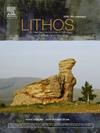岩浆岩基团矿物(EGM)的岩浆稳定性以及 EGM 和围岩硅不饱和熔体之间的元素分布
IF 2.5
2区 地球科学
Q2 GEOCHEMISTRY & GEOPHYSICS
引用次数: 0
摘要
裸晶群矿物(EGM)是围碱性硅不饱和熔体的独特示踪剂。它们作为高硬度元素(HFSE,如 Zr、Nb、Ta)和稀土元素(REE)的潜在资源受到全球关注,而这些元素是现代技术的关键材料。一般来说,岩浆结晶 EGM 的主要条件是母体熔体中的 Zr 浓度达到饱和。在温度为 750 至 1000 °C、压力为 100 至 200 兆帕的条件下,研究了 EGM 在 Na2O-CaO-Al2O3-SiO2 ± H2O 体系的碱性熔体中的溶解度。运行产物中新形成的结晶相有 EGM 晶粒、parakeldyshite 和白云石。EGM 在 750 至 900 ℃ 之间比较稳定,而在 900 至 1000 ℃ 之间则不一致地熔化成霰石。在750-850 °C的名义干燥条件下,从过碱二氧化硅不饱和熔体中结晶出EGM需要熔体中至少有0.2-0.22 wt%的ZrO2。在添加 H2O 的实验中,在相同的温度区间内,ZrO2 的浓度要高得多(1.1-2.85 wt%)才能达到饱和。由于 EGM 熔体分布系数(D)随温度下降而变化,从 2 到 90 不等,因此 REE 和 HFSE 与裸晶群矿物高度兼容。在 Zr 溶解度最高的实验中,即在高温和水合成分中,D 值最低。轻稀土元素(尤其是 La)的 D 值往往低于重稀土元素。本文章由计算机程序翻译,如有差异,请以英文原文为准。
Magmatic stability of eudialyte-group minerals (EGM) and element distribution between EGM and peralkaline silica-undersaturated melts
Eudialyte-group minerals (EGM) are unique tracers of peralkaline silica-undersaturated melts. They receive global interest as potential resources for high-field-strength elements (HFSE, e.g., Zr, Nb, Ta) and rare-earth elements (REE), which are critical materials for modern technologies. The main condition for magmatic crystallization of EGM in general is that the concentration of Zr in the parental melt should reach saturation. The solubility of EGM in peralkaline melts from the system Na2O–CaO–Al2O3–SiO2 ± H2O at temperatures between 750 and 1000 °C and pressures of 100 and 200 MPa was investigated. Newly formed crystalline phases in the run products are EGM grains, parakeldyshite and albite. EGM are stable between 750 and 900 °C, and melt incongruently to parakeldyshite between 900 and 1000 °C. EGM crystallization from peralkaline silica-undersaturated melts at nominally dry conditions and 750–850 °C requires a minimum of 0.2–0.22 wt% ZrO2 in the melt. In experiments with the addition of H2O, saturation is attained at much higher ZrO2 concentrations (1.1–2.85 wt%) in the same temperature interval. REE and HFSE are strongly compatible with eudialyte-group minerals as the EGM-melt distribution coefficients (D) vary from 2 to 90 with falling temperature. The lowest D values are observed in experiments with the highest Zr solubility, i.e., at high temperature and in hydrated compositions. Light REE and especially La tend to have lower D values than the heavy REE.
求助全文
通过发布文献求助,成功后即可免费获取论文全文。
去求助
来源期刊

Lithos
地学-地球化学与地球物理
CiteScore
6.80
自引率
11.40%
发文量
286
审稿时长
3.5 months
期刊介绍:
Lithos publishes original research papers on the petrology, geochemistry and petrogenesis of igneous and metamorphic rocks. Papers on mineralogy/mineral physics related to petrology and petrogenetic problems are also welcomed.
 求助内容:
求助内容: 应助结果提醒方式:
应助结果提醒方式:


